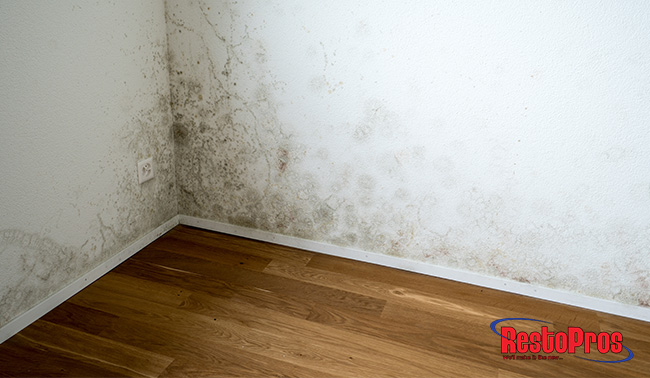Exposure to dampness or mold is the estimated cause of a quarter of all asthma cases in the United States. Even for non-asthmatic homeowners, living with a mold or mildew problem can pose serious health threats. Answering the mold vs. mildew question starts with learning what to look for. The experts at RestoPros are here to share our advice on how to spot the difference.
Mold vs. Mildew: Similarities
-
Environments
-Both mold and mildew are types of fungi that flourish in moist, humid conditions with scarce light.
-Both mold and mildew grow when spores or seeds find their way into environments that are conducive to colony growth.
-
Affected Hosts
-Neither mold nor mildew can grow on synthetic materials such as plastic and metal-based products.
-
Odors and Physical Symptoms
-Both mold and mildew produce a similar musty odor.
-Both mold and mildew can cause similar physical symptoms to humans who are exposed.
Mold vs. Mildew: Differences
-
Appearance
-Mildew can be downy or powdery. Downy mildew starts as yellow spots that become brighter and then turn brown in color. Powdery mildew is whitish in color and slowly turns yellowish brown and then black.
-Mold is black, yellow, or green with a fuzzy or slimy texture. Severe mold growth looks like moss and can cause rot in its effected host.
-
Growth Patterns
-Mildew is a type of mold that has flat growth patterns. Unlike mold, mildew remains on the surface of its host where is can be easily removed. Mildew is drawn to moisture and grows on damp surfaces like your kitchen, bathroom, and basement. You can find mildew growth in toilets, sinks, tubs, showers, and on bathroom walls.
-Mold is a fungus that grows in patches which penetrate beneath the surface of its host. Mold grows on living sources, including food, drywall, paper, and wood. Mold can often grow on your ceilings, window sills, and walls.
-
Effects on the Host
–Mildew can harm the food or plants upon which it grows, but usually does not cause any lasting damage to other surfaces such as tile floors or bathroom mirrors.
–Mold can damage entire structures because it penetrates beneath the surface of its host.
-
Effects on Exposed Humans
–Mildew can cause similar allergic reactions to those caused by mold, such as coughing, sneezing, headache, sore throat, and respiratory problems. However, mildew is much easier to eliminate because it remains on the surface of its host.
–Mold can pose a serious threat to your health. It can trigger sinus problems, sneezing, coughing, wheezing, sore throat, migraines, itching, rashes, fatigue, and even depression. Mold is difficult to remove because it penetrates below the surface of its host.
So, now you know some signs to look for when answering your mold vs. mildew question, but what should you do about your problem? Contact the experts at RestoPros for immediate mold testing and remediation today!

